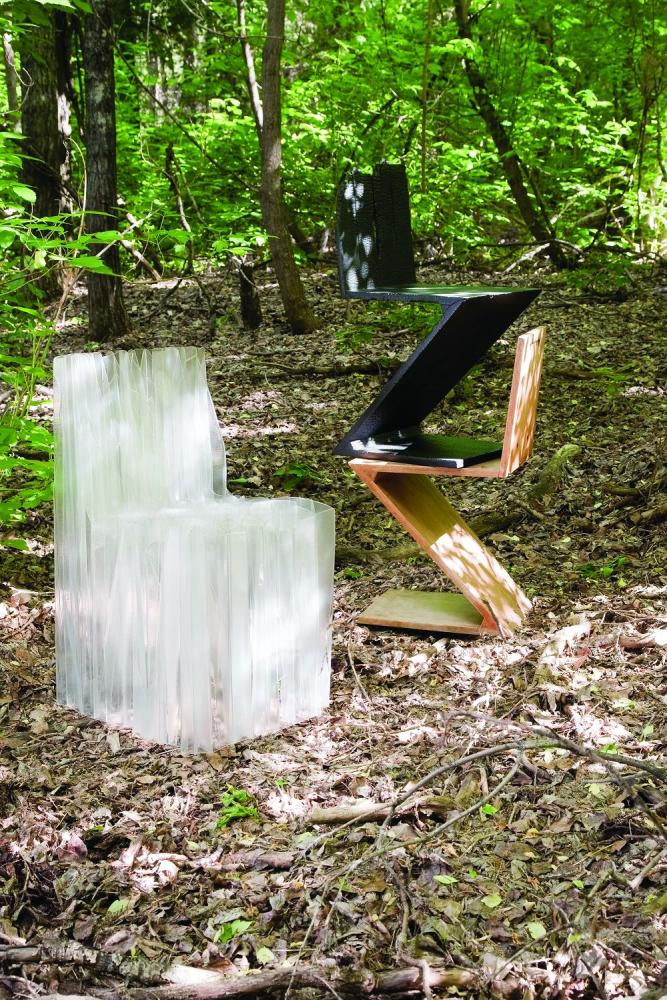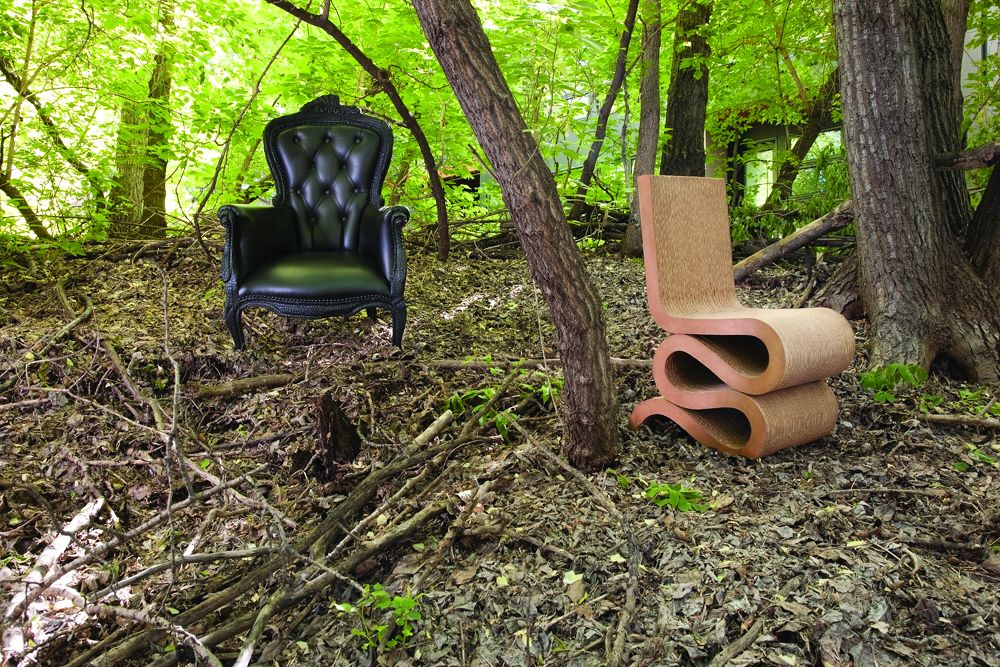
Clockwise from left: Marcel Wanders, Knotted Rouge chair, carbon and aramid fibre, 2006. Mathias Bengtsson, Spun Chaise, spun carbon fibre, 2003. Verner Panton, Cantilever chair, hard polyurethane foam, 1968. Philippe Starck, Hudson chair, mirror-polished aluminum, 2000. Frank Lloyd Wright SC Johnson chair, enameled aluminum, upholstery and brass, 1938. Oscar Zieta, Chippensteel Copper chair, laser-cut inflated copper, 2009. Patrick Jouin, One_Shot.MGX stool, laser-sintered resin, 2006.
In the mid-1930s, Frank Lloyd Wright, eminent architect of the renowned SC Johnson Administration Building, designed a chair for the facility in Racine, Wisconsin. Hundreds of these otherwise unremarkable rose-coloured chairs with casters were manufactured for offices in the building.
Years later, when a display company that had set up several trade shows for SC Johnson was cleaning house, five or six of the chairs were sent to the dumpster without a second thought.
The story goes that one employee took three of them home to schlep auto parts around his garage. A few years later, he tried, unsuccessfully, to sell them at two rummage sales for $25 apiece.
“It looks like an ugly office chair, so you can understand why someone would discard it in a dumpster,” says chair expert Brian Stonehocker. “Frank Lloyd Wright originally designed the chairs with three legs, but everyone kept falling off them. When they called him in for a meeting to complain about the chairs, he sat on one, saying they were perfectly fine. Then he fell off. You can see where it was modified in the front.”
Last year, Stonehocker and Denis Liboiron acquired one of the now highly coveted SC Johnson Chairs for the couple’s Mill Creek home library. The famed seat (most are preserved in the SC Johnson Administration Building as part of its historic designation), made of tubular steel, brass and what Liboiron refers to as “bomb-proof fabric,” is Stonehocker’s favourite acquisition in an impressive collection of more than 50 pieces from all over the world. “It’s the Holy Grail of chairs for collectors,” adds Liboiron.

Though Liboiron and Stonehocker are mum on how much they paid for their Wright chair, the Journal Times, a Racine, Wis. newspaper, reported that one of the famous, thrice-rejected chairs sold for $12,000 in an online auction in late 2008.
Liboiron and Stonehocker started their collection 10 years ago, after discovering a shared appreciation of chairs. As an interior designer, Liboiron looks at furniture primarily for its aesthetic value and comfort. For Stonehocker, a physician, it’s more about the technology and process. It’s the age-old form-versus-function debate – without the debate. They are both passionate about single-seat furniture.
Liboiron is so serious about the business of chairs that when a black vinyl Egg Chair suddenly showed up at the couple’s front door, his first reaction was more of suspicion than delight.
“There’s a lot of bad copies of that chair,” says Liboiron. “When I swung the door open, there was an Arne Jacobsen chair. I should have been jumping up and down, but the first thing I said was, ‘Is it real?'” Left: Patrick Jouin, Chaise solid C1, stereolithography resin, 2008. Top right: Maarten Baas, Where There’s Smoke chair, burnt and lacquered cherry wood, 2003. Bottom right: Gerrit Rietveld, Zig Zag chair, elm and brass, 1932.
It was real, and a gift from Stonehocker, who had found it on eBay. The Egg Chair, purchased in 1966 by a style-conscious librarian for $232, had spent years in a library in Halifax. When the library discarded it, the woman took it home and it eventually found its way to her granddaughter’s house. On a trip to New York, the granddaughter saw the same chair for sale.
“She saw how much they were worth and came home and threw it on eBay the next day,” says Stonehocker. (Some online estimates show the chair is worth between $3,000 and $5,000.)
Liboiron and Stonehocker are very selective about the pieces they add to their collection. They started out looking for designs with historical significance, but as quality pieces became harder to find, they shifted their focus to the process and innovation of new pieces. “The most interesting design isn’t just beautiful; it reflects what’s going on in society,” says Stonehocker. “I started thinking, ‘Why am I buying an OK Eames piece from the 1950s when we’ve got some amazing design happening right now?'”
This new direction led them to French designer Patrick Jouin, who designs furniture using “stereolithography,” or “additive manufacturing,” or “rapid prototyping.” Whatever it’s called, this process of 3-D printing leaves even carpenters speechless.
Holding up an eggshell-coloured, foldable stool called the One_Shot.MGX (featured in the permanent collections of the Museum of Modern Art and eight other museums), Stonehocker explains how 3-D blueprints for the stool are entered into a computer and a copier makes it using polyamide powder and a laser: “It’s actually designed so it comes out of the machine all in one piece,” says Stonehocker. “It’s printed three-dimensionally, with all 36 articulated hinges. Where the laser hits the powder, it turns to a solid, and where it doesn’t hit, it stays in powder form.” When it’s done, it’s lifted from pile of polyamide powder and ready to use.
Liboiron says traditional builders look at it and say, “‘There should be no way you can construct this because of the way the hinge system works. There should be a pin and a bolt in it.'”
Danish designer Mathias Bengtsson is the mastermind behind another of collection favourite, the Spun Chaise. It’s made from carbon fibre and constructed with the same process NASA uses to make rocket-fuel tanks, according to Stonehocker. The result is a chaise that weighs only about eight pounds, but can support the weight of several people. Liboiron says Bengtsson is unapologetic in his preference for designing pieces that regard form over function.
“Anyone can make an upholstered chair that’s beautiful,” he says. “His furniture has a different purpose. It makes you think, ‘Wow, how did he do that?'”
The chair aficionados regularly attend Design Miami, a global fair for design enthusiasts, to meet designers, learn about their processes and to add new additions to their collection. For them, it’s about acknowledging that the artistic pieces we see in magazines and catalogues actually required the touch, virtual or literal, of human hands.
They’ve come to realize just how small the chair collecting community is. “All of the chair collectors know each other,” says Stonehocker. “There’s only five or six SC Johnson chairs out there, and through my friends, I know where almost every one of those chairs are.”
While much of their impressive collection grew from making contacts with designers, going to Design Miami and bidding at intense auctions, Liboiron points out one chair in their home’s “lower level” (he hates the word basement) that he fluked out and found for $5 at a west Edmonton Goodwill. It’s a teak, mid-century modern lounge chair. “The joke is that I paid five dollars for the chair and $800 to recover it,” Liboiron says. But he’s since seen this iconic Canadian design sell for up to $1,500. “Because of that little tease, I go to that Goodwill every week now, and I haven’t seen anything since.” Left: Maarten Baas, Smoke armchair wood and clear epoxy resin, 2004. Right: Frank Gehry, Wiggle chair cardboard and masonite, 1971.
The Collection:
Chippensteel Copper by Oscar Zieta >>One of only 20 that were produced, this chair was made using laser-cut, robot-welded copper, which was then inflated with high-pressure air. “It’s all about using a minimal amount of material and about minimal shipping space,” says Stonehocker. “You could ship thousands of these and they can be blown up wherever they end up.” The chair was originally designed in stainless steel, but Stonehocker, whose favourite metal is copper, asked Zieta to make him one in a warmer colour.
easy edges by Frank Gehry >>This chair is from a 1971 furniture series, and made from layers of corrugated cardboard. Liboiron says Gehry stopped production of the chairs because they were such hot sellers and he feared it would ruin his architectural career if he became known as a furniture designer.
Chaise Solid C1 by Patrick Jouin >>Best described as an ethereal iceberg, its airy translucence suggests that it might not hold a person’s weight. But it does. “This is going to change the world,” Stonehocker says of the 3-D printed chair. “Now you can design things that you could never manufacture or mould in any way.”
Panton Chair by Verner Panton >>This single-unit, cantilevered chair from its first run of production is made of varnished high-resistance foam. It is still being copied today, and it’s special to the couple because Panton signed the back of it before he died.
Prototype by Philippe Starck >>Liboiron playfully calls this one “the chair that has every ’80s clich rolled up into one piece.” Studio 54 co-owner Ian Schrager commissioned this prototype for his boutique hotels, but it never went into production. “At first, we were, like, ‘Ewww, it’s so ’80s, but that’sbecause we lived through the ’80s,” says Liboiron. “We had to stop ourselves from discounting it because it does represent a significant period in terms of time and design.”
Zig Zag Chair by Gerrit Thomas Rietveld >>This particular solid elm-wood chair was made in the 1930s for a family that had moved from the Netherlands to Canada. From a set of eight, four were sold and the other four became part of a Montreal museum collection.
Smoke Armchair by Maarten Baas >>The designer takes antique classic chairs and literally burns them. Then, he preserves them with a clear epoxy coating. Liboiron’s practical side loves this chair because it is so comfortable to sit in.
Vilbert by Verner Panton (for Ikea in 1994) >>This melamine-coated, MDF chair was such a horrible seller, says Liboiron, that it went out of production after only a year. “Ironically, years later, it’s become a collectible.”
Like this content? Get more delivered right to your inbox with Ed. Home & Style
Discover the cool things we’re obsessing over.








